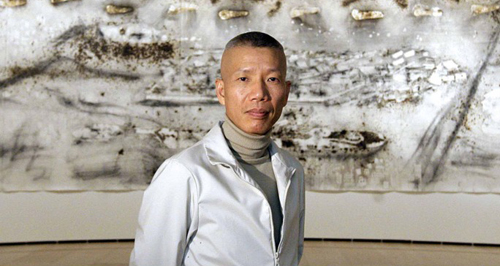Cai Guo-Qiang was born in 1957 in Quanzhou City, Fujian Province, China. The son of a historian and painter, Cai was trained in stage design at the Shanghai Drama Institute. His work has, since the outset, been scholarly and often politically charged. He initially began working with gunpowder to foster spontaneity and confront the suppression that he felt from the controlled artistic tradition and social climate in China at the time. While living in Japan from 1986 to 1995, he explored the properties of gunpowder in his drawings, an inquiry that eventually led to his experimentation with explosives on a massive scale and to the development of his signature explosion events, exemplified in the series Projects for Extraterrestrials. Wildly poetic and ambitious at their core, these events aim to establish an exchange between viewers and the larger universe around them. His large-scale installations, which have drawn upon feng shui, Eastern philosophy, and contemporary social issues as a conceptual basis, utilize a site-specific approach to culture and history that encompasses diverse mediums including drawing, video, and performance art. Cai quickly achieved international prominence during his tenure in Japan, and since 1995, he has lived in New York.
Cai was selected as a finalist for the 1996 Hugo Boss Prize and was awarded the Golden Lion at the 48th Venice Biennale in 1999. His solo exhibition at Mass MoCA won Best Monographic Museum Show, and Inopportune: Stage One won Best Installation or Single Work in a Museum from the International Association of Art Critics, New England in 2005. In 2007, he was awarded the 7th Hiroshima Art Prize. In 2009, he was awarded the 20th Fukuoka Asian Culture Prize.
Among his many solo exhibitions and projects are Cai Guo-Qiang on the Roof: Transparent Monument, Metropolitan Museum of Art, New York, 2006; Inopportune, Mass MoCA, North Adams, 2005; Traveler, Freer Gallery of Art and Arthur M. Sackler Gallery, and Hirshhorn Museum and Sculpture Garden at the Smithsonian Institution, Washington, D.C., 2004; Transient Rainbow, Museum of Modern Art, New York, 2002; Cai Guo-Qiang, Shanghai Art Museum, Shanghai, 2002; APEC Cityscape Fireworks Show, Asia Pacific Economic Cooperation, Shanghai, 2001; An Arbitrary History, Musee d’art Contemporain Lyon, France, 2001; Cultural Melting Bath: Projects for the 20th Century, Queens Museum of Art, Queens, New York, 1997. Cai was Director of Visual and Special Effects for the opening and closing ceremonies of the 2008 Summer Olympics in Beijing. He curated the first China Pavilion at the 51st Venice Biennale, 2005, and organized and curated BMoCA: Bunker Museum of Contemporary Art, Kinmen, Taiwan, 2004. Along with DMoCA and UMoCA, BMoCA is one of three alternative art museums founded and curated by Cai in the series Everything Is Museum.
Cai Guo-Qiang’s retrospective at the Solomon R. Guggenheim Museum, New York opened in February 2008, traveled to the National Art Museum of China in Beijing in August 2008 and then to the Guggenheim Bilbao in March 2009. Currently, Cai is the subject of another large-scale retrospective titled Hanging Out in the Museum, which opened in November 2009 at the Taipei Fine Arts Museum. This December, the Philadelphia Museum of Art and The Fabric Workshop and Museum will jointly hold the solo exhibition Fallen Blossoms.

